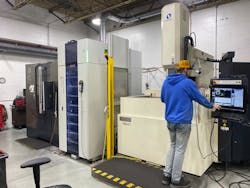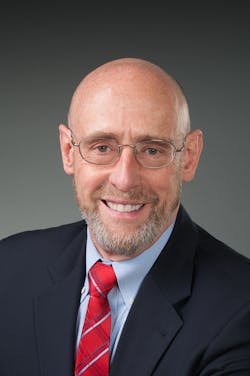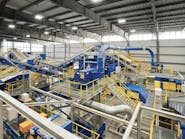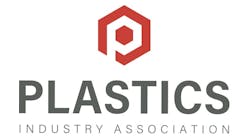By Karen Hanna
Years-long turmoil in the supply chain has seen ships parked for weeks at port while store shelves are stripped of essentials. For advocates of made-in-America manufacturing, the case for producing goods closer to the sources of demand and raw-material supply couldn’t be more apparent.
At Premier Plastics’ two plants in Salt Lake City, seven thermoforming lines are running two shifts a day, five days a week. But the company is accustomed to running three shifts — if only it could find enough workers. Company founder Jim Holbrook said he’d like to hire more people, in part to accommodate burgeoning growth from customers eager to bring work back from overseas.
Related: 3D printing helps vacuum manufacturer evolve and create jobs
“That’s the big one for most of our clients that we were talking to. They’re either not even able to get product, or what they’re getting is not of the quality that they have had in the past,” Holbrook said.
To boost capacity, the company recently added a SencorpWhite thermoformer and a form-fill-seal machine that can load cartons automatically.
Long-awaited return
More than 40 years after the U.S. manufacturing sector peaked at 19 million-plus jobs, made-in-America advocates see a reversal in the forces that once shipped production out of the country. Now, they say, it’s becoming clearer that reshoring would bring greater predictability, while producing benefits in terms of cost and environmental impact.
The Reshoring Initiative — which began in 2010 as one man’s mission to reverse job losses — lately has been tracking victories, with ballpark figures of the number of reshored jobs and jobs created by foreign investment in the U.S. increasing from 6,000 in the year of its founding to 260,000 in 2021.
In 2022, 350,000-plus jobs came back, Reshoring Initiative founder and President Harry Moser said. And, in testimony he delivered to a U.S. Senate committee in the summer, he predicted 400,000 for this year.
While it’s sometimes difficult to distinguish jobs created by expansion from those created by reshoring, Moser has confidence that at least 90 percent of the jobs included in his figures are the result of reshoring or foreign direct investment (FDI) — when a company with a headquarters based outside the U.S. expands in the U.S.
According to the Reshoring Initiative’s most recent report, issued in the third quarter of 2022, “Reshoring is exceeding FDI in job creation for the third year in a row.”
Since its founding, the organization has tallied 1.6 million jobs created through reshoring or FDI.
The initiative aims to even the trade deficit, which would mean reshoring about 6 million manufacturing jobs — a goal Moser said he believes is achievable, as long as the country and companies can provide a way to train workers to fill them.
“They no longer can put the [help-wanted] sign up and expect decent people to walk in; they have to work, they have to train within the company, they have to work with the community college to get the smart students to get them in,” he said. “And the ones that do that are doing fine.”
Efforts to bring jobs back to the U.S. will shorten the supply chain, provide markets and consumers with stability and reduce carbon footprint, among other benefits, said Greg Kozera, director of marketing for Shale Crescent USA, a nonprofit that promotes shale gas resources in Pennsylvania, Ohio and West Virginia.
“Here’s how you can reduce your emissions and your costs at the same time,” Kozera said. “What an opportunity! You can be more cost-competitive; you can cut your costs, reduce your supply chain, create a more dependable product line and save money … when you localize those supply chains.”
Trouble on the water
The pandemic called into question a simple formula that has worked for many businesses in the U.S. for decades. Tariffs beefed up under President Trump, pandemic-related shutdowns and supply chain clogs have affected companies both big and small.
Plastics parts makers are no exception.
In 2016, when he started a stand-up paddleboard business, Rob Bossen joined so many others to follow a time-worn road map: Source goods from overseas, where labor is cheaper, and sell them where disposable incomes are higher. Seven years later, while Grey Duck Outdoor is still dependent on paddleboards from China, it’s also diversifying — as Bossen works with two other people to build canoes in the Boundary Waters Canoe Area Wilderness in Roseville, Minn.
Related: Grey Duck Outdoor brings canoe-making back to U.S.
The vulnerabilities exposed by the pandemic hit home for him, in ways he could never have predicted. As supply shortages and plant shutdowns in China rocked the supply chain, Bossen realized he couldn’t absorb the costs of shipping foam boards thousands of miles around the world. Instead, he passed “a massive, massive price increase” onto his customers.
“Containers were just sitting off port for weeks at a time. … It used to cost between six and 10 thousand [dollars] for me to land a container into Minneapolis, and that ballooned to $30,000 with tariffs and ocean freight and rail costs. When you’re talking about a paddleboard that you can put, let’s say, 120 paddleboards in a container, when it goes from six to $10,000 to $30,000, you’re looking at a couple-hundred-dollar difference, just literally in freight costs,” he said.
The global issues also have had ripple effects in tiny North Vernon, Ind., where mold maker Decatur Mold Tool & Engineering Inc. is adding 14,000 square feet to its production space.
“In the past, we have built quite a bit of our molds in China; we actually have an arm in China. Beginning with the tariff, and then moving into COVID and supply chain pressures, we have found that our customers are much more willing to consider a domestically built mold,” majority owner and President Rhonda Lustenberger said.
Plastics’ potential
Given how many of its jobs currently are performed elsewhere, plastics manufacturing — with its automation and mega volumes — has been among the industries most affected by reshoring.
“We see reshoring both to the U.S. and to Mexico,” said Vanessa Malena, president of Engel North America, York, Pa. “Higher tariffs, rising shipping costs, supply chain concerns and political unknowns abroad make reshoring a good choice for many companies. Based on these circumstances, China is no longer the more economical choice. It has also become more challenging to do business with China because of the heightened regulations stemming from the effects of the ongoing pandemic.”
The U.S. imports about $53 billion in plastic-based products a year, according to a report released in December 2022 by Shale Crescent USA. Of the $500 billion in goods China ships to the U.S., about 5 percent are made from plastic — a number that’s risen from $8 billion worth in 2010 to about $25 billion now. In all, since 1985, it has shipped $8 trillion in consumer goods to the U.S., with most of the volume making the trip in the last decade.
Related: Shale Crescent says deposits could fuel plastics jobs
As the value and number of goods produced in China have risen, the number of U.S. manufacturing jobs has fallen.
The U.S. Bureau of Labor Statistics makes available data regarding plastics and rubber manufacturing dating to 1990. Between then and 2022, the number of jobs peaked at 959,100 in 2000 and cratered at 607,500 in 2009; at the end of 2022, it stood at 749,800.
But the category now is experiencing growth, ranking No. 10 in a list compiled by the Reshoring Initiative of the industries with the most reshored jobs since 2010, with 47,766. The list includes a number of industries that are heavily dependent upon plastics: Transportation equipment is No. 1, with 368,522 jobs; followed by computer and electronic products, with 184,496; machinery, 152,659; medical equipment and supplies, 139,451; and electrical equipment, appliances and components, 60,434. Primary metal products, apparel and textiles, and chemicals also made the top 10.
To businesses looking for manufacturers, Shale Crescent USA’s Kozera asks one question:
“Can you make it?” he asked. “If you can make it, you can probably make it less expensive than they can over there.”
Paying for predictability
As the world emerges from the pandemic, Moser and others say businesses are reassessing the costs and tradeoffs of a global supply chain.
“It used to be a system that worked very well but had a lot of glitches in it, and now it’s a system that doesn’t work very well,” said Moser, who worked in the machining industry for years before retiring as president of AgieCharmilles LLC, Lincolnshire, Ill., and founding the Reshoring Initiative. “And because we’ve had the experience of Fukushima, COVID, the Suez Canal, Russia/Ukraine, and, hanging over it, China — the risk of some kind of a decoupling or kinetic event over Taiwan … companies are deciding … ‘[We’ve] got to get this stuff out of China.’ ”
Shay Luo, a principal for consulting firm Kearney, cautioned that localizing production is easier said than done, especially when it comes to separating from China’s juggernaut.
But the impulse is building, she said, and some manufacturing is poised to move.
In an era that’s seen the word “unprecedented” become a cliché, Luo said businesses now are more willing to pay extra for predictability. “Black swan” events have inspired a new mindset. In a Kearney analysis of small, medium-sized and large companies open to reshoring, a number of factors unrelated to cost stand out, including product quality, lead times and carbon footprint.
“I think before [the] pandemic, everyone’s focusing on costs; you have to be the lowest cost,” Luo said “However, during the pandemic, because of the uncertainties in the supply chain, supply chain resilience [and] agility become also a very important perspective for companies to design their supply chain.”
Making your case
In finding ways to grow domestically, Holbrook, Bossen and Lustenberger are bucking a decades-long movement that placed one factor above all others: price.
For some, it’s still a sticking point. But Moser, Kozera and Luo say manufacturers now can offer new arguments to offset cost concerns.
At Westec Plastics Corp., Livermore, Calif., which employs 80 to 90 people, business development manager Mustafa Hossaini said customers are moreopen to considering domestic production. They’re drawn to advantages like improved communications and a shorter supply chain, with better assurance of access to materials.
“We’ve definitely seen a strong uptick in quoting opportunities. Now the challenge is, there is a little sticker shock. So, customers say, ‘We want to reshore, we want to get out of Asia, we want to get out of China.’ And then when you quote them a project, when they actually see the tooling costs, and they see the production costs, the contract manufacturing costs, maybe even the lead times, sometimes, you might not hear from them again,” he said.
To help brand owners and manufacturers better quantify the benefits of reshoring, the Reshoring Initiative has developed a calculator that Moser says makes the math more palatable — by exposing to prospective customers costs that otherwise are opaque or overlooked. The initiative’s Total Cost of Ownership Estimator is available to manufacturers, such as molders, looking to make their pitch vs. imports. Meanwhile, its Import Substitution Program helps manufacturers identify potential downstream customers.
With the costs of shipping and tariffs, imports once considered “cheap” aren’t such a good deal anymore, Moser said.
“Price difference is big, and companies go for the price,” he said. “But, as the companies start to do the math correctly, and look at all of the costs and risks, when they start adding in the duty and the freight and the carrying cost of inventory, even without thinking about decoupling with China, even without putting in the Section 301 tariffs, 20 to 30 percent of what they’re importing — this is broad industry, not just plastics — 30 percent of what’s being imported would be more profitably sourced here.”
Considering all the other factors, Tony Firth, VP of sales and marketing for IMM maker Tederic North American Machinery Inc., based in Palmetto, Fla., said the priority on price is changing.
“This reshoring is not price-driven. Rather, it is a function of low confidence in the stability of global supply chains,” he said.
Products with the best economics for reshoring include those that are especially expensive to ship, as well as items that can be made in high volumes with relatively little labor. Alternatively, they might require frequent design changes.
Items that could be subject to wild swings in demand — such as toys based on movies or cartoons — also should be made close to their consumer base “because they need a supply chain to be short, so they will be able to capture the upside of the market,” Kearney’s Luo said.
With highly automated processes, items as simple as plastic cutlery can be made more cheaply in the U.S., she said.
Technology levels the playing field
In its report touting U.S. competitiveness, Shale Crescent USA takes issue with an offshoring trend that valued volume discounts over innovation, stating, “Labor, utilities and land were cheap in Asia, and especially China. Asian countries had a culture that was both hard-working and quick to capitalize on imitation versus innovation.”
Winning jobs back will require a return to innovation, according to manufacturers and made-in-America advocates.
“Given the fact that our wages are three times as high as China and seven times or something as high as India, you have to automate the heck out of it to get the economics to work,” Moser said.
By September, the company hopes to have installed two new relatively large Makino mills served by a Fanuc robot, a third mill served by a Fanuc and an electrical discharge machining cell served by an Erowa robot, Lustenberger said.
“The goal is to really decrease the gap in costs between the U.S., between building here, and low-cost countries where our customers might be tempted to go,” she said.
Can a mold maker really take tooling jobs away from overseas?
“Never say never,” she said. “I knew it would be hard, but I do feel like the direction we’re going, we have a really good shot at getting that gap pretty close.”
Lustenberger said she believes the new automation will lower costs — and allow her company and its customers to gain greater control over quality, and give them the flexibility and agility to deal with the changing supply chain.
“I think that’s going to be a significant piece of the puzzle because people will be able to bring things to market more quickly, because we’re taking time off of that supply chain, and you don’t have to worry about global disruptions, whatever that looks like,” she said.
Ultimately, she’d like to add to the number of people she’s able to employ in her 6,000-some-
person town and ensure that Decatur Mold is strong when she hands it off to the next generation.
A focus on automation — like that taken by Decatur Mold — could provide the path forward, supply chain experts say.
“No question that millions of jobs can be brought back just by companies doing the math correctly,” Moser said.
Karen Hanna, senior staff reporter
Contact:
A.T. Kearney Inc., Chicago, shay.luo@kearney.com, www.kearney.com,Reshoring Initiative, 847-867-1144, info@reshorenow.org, www.reshorenow.org
Shale Crescent USA, Marietta, Ohio, 888-529-1650, www.shalecrescentusa.com
Karen Hanna | Senior Staff Reporter
Senior Staff Reporter Karen Hanna covers injection molding, molds and tooling, processors, workforce and other topics, and writes features including In Other Words and Problem Solved for Plastics Machinery & Manufacturing, Plastics Recycling and The Journal of Blow Molding. She has more than 15 years of experience in daily and magazine journalism.









